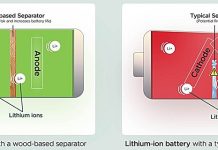
Researchers at Purdue University’s College of Engineering, Xiulin Ruan and Amy Marconnet, have developed a groundbreaking continuously tunable thermal regulator using compressible graphene foam composites.
This innovative device holds great potential for improving battery safety and performance in electronic devices and systems, such as battery thermal management, vehicle comfort, and thermal energy storage.
As batteries and electronic devices become more powerful, effectively managing heat becomes increasingly important.
Similar to how humans have a narrow range of comfortable temperatures, batteries and electronic devices also require a specific temperature range to function optimally.
Extreme temperatures can lead to issues like thermal runaway, which can cause battery damage, poor performance, and even fires or explosions.
The thermal regulators developed by Ruan and Marconnet offer significant advancements over conventional technology.
While conventional thermal switches can only change the heat dissipation pathways in an on-off manner, the Purdue thermal regulators can continuously adjust the thickness of the material inside, allowing batteries to adapt to different climates and seasons seamlessly.
The researchers employ commercially available compressible graphene foam, composed of tiny carbon particles with air voids in between. When the foam is uncompressed, it acts as an insulator by trapping heat within the air pockets.
Conversely, when the foam is compressed, the air escapes, enabling efficient heat conduction. By adjusting the compression level of the foam, the amount of heat transfer can be precisely controlled.
In experiments conducted at Purdue University, Ruan and Marconnet observed that fully compressing the foam to 0.2 millimeters increased the thermal conductance by a factor of 8.
Similar results were achieved in different environmental conditions, demonstrating the regulator’s adaptability to ambient temperatures ranging from freezing to warm temperatures.
Initially designed for electric vehicle batteries, the continuously tunable thermal regulator has potential applications in various fields.
It can be used in sensors, detectors, and electronic devices that require precise temperature maintenance. Additionally, it may prove valuable for space vehicles that face extreme temperature variations in harsh environments.
The researchers are focused on further enhancing the thermal conductance range achievable with the regulator. By improving the performance ratio, they aim to create a more effective regulator that can adapt to different thermal demands.
They also plan to automate the regulator’s adjustment process, potentially incorporating temperature sensors for automatic parameter adjustment.
The continuously tunable thermal regulator developed at Purdue University offers a significant breakthrough in thermal management for batteries and electronic devices.
By employing compressible graphene foam composites, this innovative device enables efficient heat dissipation and insulation across a wide temperature range.
As technology continues to advance, such thermal regulators will play a crucial role in improving battery safety, extending battery life, and enhancing the performance of electronic devices in various applications.
The battery application study was published in Nature Communications; the fundamental research was published in ACS Applied Materials & Interfaces.



